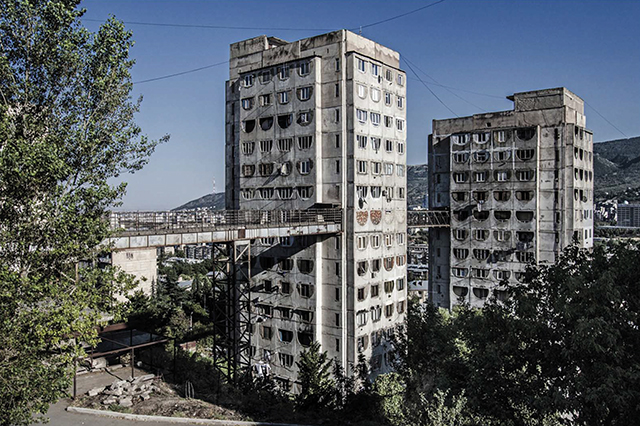This beautiful and scenic city that many of us now take for granted started as a mere mud and straw village on the silt-laden banks of the Mtkvari River. With evidence of early Bronze Age and even Paleolithic age habitation, the location has long been a natural hub of safety and community. Like many other growing cities, it was composed of hunters, gathers, herders, tradesmen, and families. As such, design and complex architecture were afterthoughts in lieu of functionality, resource management, and defense.
In the modern era, particularly during Soviet occupation, architectural styles fluctuated between the ornate and the brutish. However, Tbilisi managed to maintain much of its original charm and structural flavor. From wooden apartment homes in the old districts to the large stone multi-function structures across the city, Tbilisi has become a patchwork of classical, modern, and even some postmodern styles, each telling the story this ancient city has endured.
Prior to Soviet rule, Georgia’s regions and cities developed their architectural styles almost independently. Some influence in the capital came from neighbors and from Europe, and much of the now ubiquitous carved wooden balconies and hybrid stone and wooden structures still dominate much of the more “tourist-centric” Old Tbilisi.
After the occupation in 1921, the Soviets brought not only their armies but also their ideas, planning practices, and architecture. Much of this was centralized construction, with a building code framework focused on building massive structures that could house the growing industrial workforces. As the masses flocked to the city for their government-issued jobs, they would also be afforded a “cookie-cutter” apartment. These were designed with only the essentials in mind, something a modern soldier would describe as their “barracks.”
Naturally, during the Second World War and Georgia’s significant contribution to the conflict, little attention was given to the matter of architecture. As any of those that have traveled through Georgia’s innumerable rural settlements can attest, there still stands memorials to those who sadly never returned to their homesteads. However, upon the return of Georgia’s heroes, a new age of development began.
After the occupation in 1921, the Soviets brought not only their armies but also their ideas, planning practices, and architecture. As the masses flocked to the city for their government-issued jobs, they would also be afforded a “cookie-cutter” apartment
This first iteration of housing design gained its name from the infamous leader that reigned during the height of its popularity. The “Stalinka” became the most common form of residential structure. These brick and cinder block buildings were often modestly ornate, depending on the status of the inhabitants: Smaller 3-story buildings with a more modest appearance and decor for the working classes, and larger 5 or 6 story buildings for those in the Party’s favor or employ. Many of those buildings in Tbilisi still stand today, displaying their age with grace. Using large stone fixtures, balconies, and decorative facades, these buildings used to line most of the main thoroughfares, such as is seen in Vake.
Following this phase, the birth of the “Khrushchyovka,” named in a similar way as its predecessor after the ruler Nikita Khrushchev, rose to prominence. With a need for increased housing in the Soviet Union’s urban sprawl, designers pivoted to a more industrious method of construction. This resulted in large concrete panel buildings limited to a now classic 5-story model. These panels are often visible from the exterior of many of the buildings, even today.

While Soviet building standards of the time required any structure with more than 5 stories to include an elevator, and these were seen as too high-cost and superfluous, virtually all Khrushchyovkas were kept at 5 stories. Taking only two weeks to build in most cases, these rapidly became the standard across the empire. Tbilisi was no exception. Today found across the country, Georgian Khrushchyovkas are still a large part of the urban landscape, although many have been either given a facelift or somewhat modernized with newer interiors.
The final phase in Soviet architectural advancement took place under Leonid Brezhnev, aptly named the “Brezhnevka.” This chapter in urban housing expanded its predecessor’s design to include larger and taller buildings, aided with elevators. Many of these began with 9 stories, with later versions expanding further upwards. Additional amenities and minor comfort improvements to each unit separated them from previous structures.
With a need for increased housing in the Soviet Union’s urban sprawl, designers pivoted to a more industrious method of construction. This resulted in large concrete panel buildings limited to a now classic 5-story model
This style continued to be the prevailing residential architectural choice for decades after the collapse of the Soviet Union. Tbilisi, until the introduction of more modern styles, continued to utilize the Brezhnevka style, albeit with the occasional modification. One of the popular modifications of this style is the “candlestick Brezhnevka” that opts for a more vertical expansion. Growing up to 20 stories high and visible throughout the more residential districts of Tbilisi, they are some of the last iterations of the Soviet architecture movement.
As Georgia moved into independence and began assimilating with European standards, steel and glass construction has since become mainstream. However, what these structures lack is the classical allure that was so venerated by the architects of the past. While it is true that the cost of materials and labor is certainly at play when dissecting this paradigm shift, there is no denying the beauty of Georgia’s traditional design.
With influences from France, Greece, Turkey, and Persia, so much of this beautiful architecture in the city still attracts today. In addition, it also lies adjacent to Soviet block-style and modern buildings, making it all the more poignant. Bringing back this pursuit of a harmonious relationship between form and function is a worthy and promising venture for the architects of this ancient city.
By Michael Godwin














